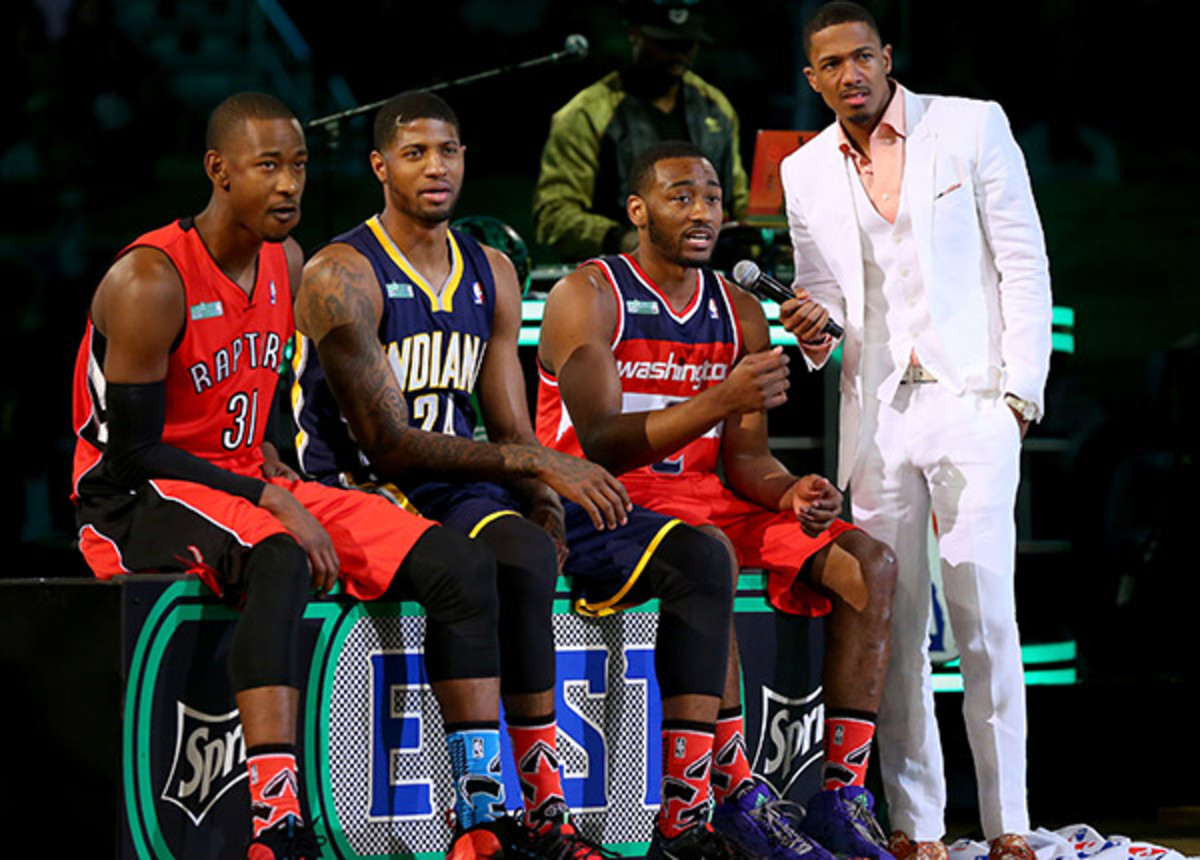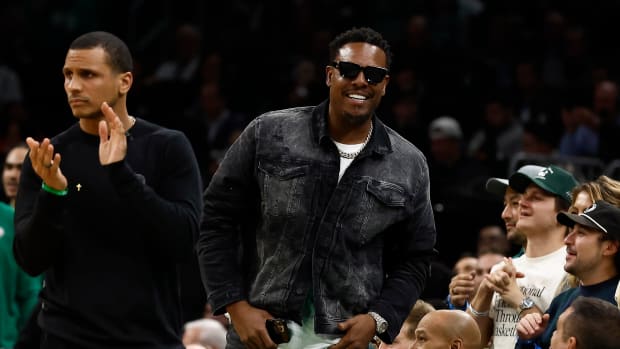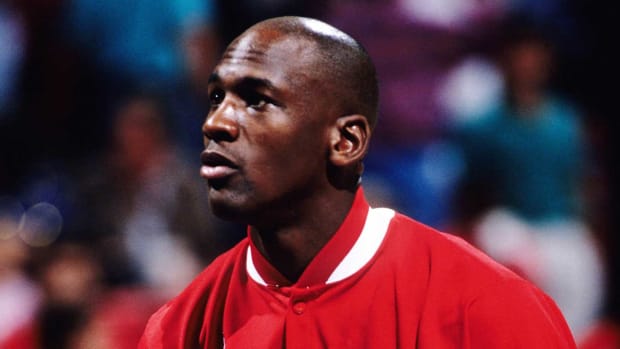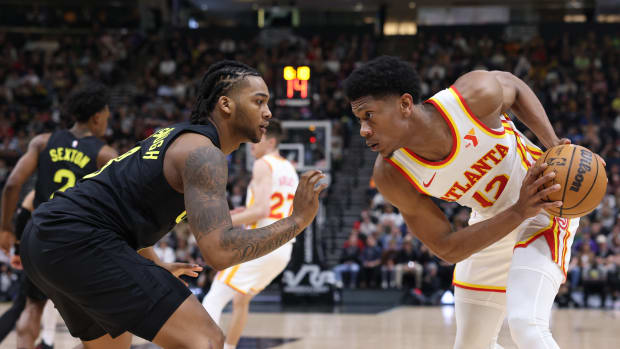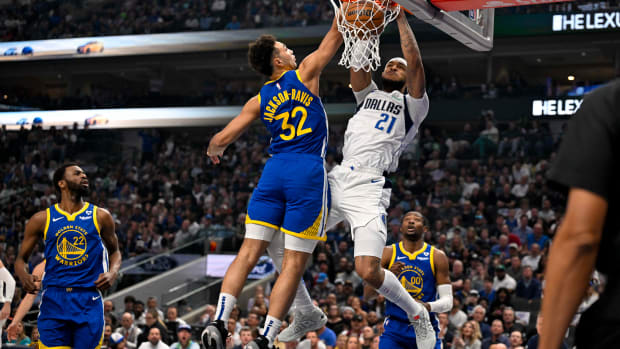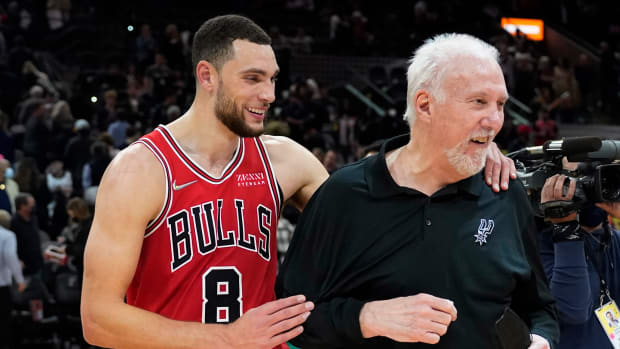Format fails 2014 NBA Slam Dunk Contest after star-studded field goes to waste
The East won the Dunk Contest in a blowout, ending the event abruptly. (Jesse D. Garrabrant/NBAE/Getty Images)
NEW ORLEANS -- Worst. Fears. Confirmed.
As soon as the Slam Dunk Contest's new format and rules were announced two weeks ago, it was immediately clear that there was a decent chance the event could end in disaster. A bad fate wasn't guaranteed but, as The Point Forward noted at the time, it was a strong possibility.
Unfortunately, that's exactly what happened at the Smoothie King Center on Saturday night. The 2014 Dunk Contest will go down as confusing, boring, underwhelming, frustrating and -- worst of all -- a logistical mess that undercut a very strong group of dunkers. So often over the years, weak fields have failed to live up to the excitement and hype of the Dunk Contest ideal; here, the Dunk Contest's format totally failed its participants by lessening the impact of their achievements and bringing an abrupt end to the action just as things were getting interesting.
The new rules -- which included a two-round format that began with a "freestyle" team-based opening round and a head-to-head, East vs. West closing "battle" round -- seemed to be making a series of calculated trade-offs.
RELATED: 2014 NBA Slam Dunk Contest grades
Instead of trusting the dunkers to shine, the contest's structure worked to minimize the impact made by a series of missed dunks. If you repeatedly missed in the "freestyle" round, your teammates would simply follow up a few seconds later with tries of their own. If you repeatedly missed in the "battle" round, you would almost certainly be quickly eliminated by your head-to-head competitor. Here, the new rules attempted to trade tradition for improved flow.
The contest also insisted on fully incorporating the conference vs. conference format used in other All-Star Saturday events, rather than keeping the focus on the individual. This included crowning all three members of the winning conference as "champions" and ending the contest when the winning conference won three "battles," as opposed to a final showdown round featuring the best dunkers, regardless of conference. That process was then supplemented with a "Dunker of the Night" award to be determined by a fan vote. Here, the new rules traded tradition and the Dunk Contest's well-established mano-a-mano vibe for a conference face-off format with no obvious benefits and a recognition for the best dunker that felt tacked on as opposed to the main attraction.
The new scoring format also deemphasized the role of the judges considerably. Rather than scoring dunks on a 1-to-10 scale and adding them up, a process that has the potential to be inconsistent and controversial, the judges faced a simpler decision this year, needing only to vote for the East or the West. Here, the trade-off was the tradition and excitement of the old scoring rules and system, and the mystique of the coveted "50" dunk, for a streamlined process that should reward the most deserving competitors.
SI.com's 2014 All-Star Hub: Analysis, results and more
And finally, the format ensured that no individual dunker would be required to do more than, say, six or seven dunks at the absolute most: roughly three or four dunks in the "freestyle" round and then an absolute maximum of three dunks in the "battle" round. Realistically , most of the dunkers could be expected to do two dunks in the "battle" round at most; as it turned out, no dunker did more than one "battle" dunk on Saturday. Back in the 1980s, by comparison, dunkers that made the final round would perform eight dunks along the way. Here, the intended trade-off was quality over quantity, with the hope that less would be more because all the participants would bring their best material out in the "battle" round, knowing they would be eliminated if they didn't.
Most of these trade-offs, with the exception of the ill-advised conference vs. conference idea, were well-intentioned, at least when considered individually. When combined, though, some serious questions were apparent immediately. What happens if one conference is way stronger than the other? Will the contest's shortened length prove to be satisfying? What happens if the two best dunkers are from the same conference? Why even hold a Dunk Contest if there's not a single, undisputed, overall champion? And why devalue the "champion" tag by giving it to three people and handing the winner a clunky "Dunker of the Night" title?
THOMSEN: Five storylines to watch in Sunday's All-Star Game
Again, these questions weren't guaranteed to become major problems, but they were glaring enough issues that the contest's rules never should have seen the light of day as is. As it turns out, all of those questions turned into huge problems on Saturday, and the result was a mostly lifeless crowd that seemed dumbfounded when it found out that the contest -- just as it was finally gaining some momentum -- was now over.
Wizards guard John Wall wound up taking home "Dunker of the Night" honors as he led the East to a 3-0 rout of the West. His final dunk involved jumping over a mascot, double-clutching and throwing down a two-handed reverse dunk, a sequence that earned a "50" from The Point Forward. But that slam, the night's best, was not followed by a face-off with Raptors guard Terrence Ross, the defending champion, or Pacers forward Paul George, both of whom impressed with through-the-legs dunks in the "battle" round. That slam also wasn't followed by any additional dunks from Wall, who had been electric during the "freestyle" round too.
No, Wall's only "battle" round dunk was followed immediately by the trophy presentation because the West's squad got blown out by the East because it wasn't up to snuff, and the format designers hadn't properly gauged the chances that this would happen.
RELATED: Non-Champions: Greatest Dunk Contest participants who never won
You can't blame Julius Erving, Magic Johnson and Dominique Wilkins, who served as judges: Ross, George and Wall were worthy head-to-head winners, although Ross was pushed hard by Blazers guard Damian Lillard and Wall handled a stiff challenge from Kings guard Ben McLemore.
You can't blame the fans: they made the right choice by voting Wall as the night's top performer.
You can't blame the dunkers: five of the six competitors (everyone except Warriors forward Harrison Barnes) put on a great show. When Lillard was eliminated, after a pretty spinning lefty dunk, it was a shame that his night, which had been a pleasant surprise, was over early. When McLemore was eliminated immediately after taking flight over Shaquille O'Neal, who was sitting on a throne, it was a shame because you knew he had more in store. When it became clear that Wall's dunk would end his night, and George's night, and Ross's night, it was an outrageous shame. Ross didn't have a true opportunity to defend his title. George never got a chance to go deeper into his bag of tricks to avenge his 2012 Slam Dunk Contest loss. And after such an original and breathtaking slam, Wall was denied the opportunity of bringing down the house at the very moment he had finally excited the crowd. Just a shame.
How is it possible that a Dunk Contest's format could leave fans feeling like they didn't get to see enough from Wall, and George and Ross and Lillard and McLemore? This wasn't trimming the fat so much as throwing the entire piece of meat into the garbage can halfway through the appetizers course.
It bothers me that Vanilla Ice was brought in to play a set -- or whatever you want to call it -- in the middle of all of this. It bothers me that a way-too-gigantic Sprite logo hung over the backdrop to remind us just how over-commercialized the event has become. It bothers me that an NBA legend like Dr. J had to hold up a tablet to cast his vote rather than a simple "10" on a piece of paper. But what really, really bothers me is that the contest's priorities were so out of whack.
Cutting down on wasted time from missed dunks is a good thing, and the "freestyle" round did serve as a nice warm-up. Cutting down on judge subjectivity and inconsistency is a good thing, and there wasn't a single truly disputable call all night. Cutting down on the total number of dunks to find an efficient path through the contest is a good thing, and the contest certainly wasn't too long (duh).
GIVE AND GO: What would All-Star Game look like with captains?
This year's contest might have accomplished those goals, but it failed to get the most out of a very talented group of athletes, it failed to put those athletes in a position where their efforts would have the potential to be enduring, it failed to generate real tension because of the conference format, and it failed to set up what could have been an historic final showdown between two All-Stars in Wall and George, and Ross, the reigning champ.
Instead of a heavyweight boxing match for a championship belt, we witnessed an all-comers track meet where half of the competitors went home with blue participation ribbons and the crowd left the building wanting more. For the 200th time -- and at the risk of being really redundant -- this was a totally foreseeable possibility.
Overall, this year's Slam Dunk Contest format did the little things OK but totally whiffed on the big picture. That the whiff was so predictable made it that much more maddening. That the conference vs. conference format helped cause the whiff because of the disparity in talent between the teams was further proof that "East vs. West" shouldn't play such a prominent role in future contests.
When the event organizers go back to the drawing board for 2015, they must realize that the current format has the potential to ruin any field. It ruined this year's group -- which included three All-Stars for the first time since 1988 -- and it's so bad that it has the potential to ruin a dream field composed of guys like Blake Griffin and LeBron James, as long as the "battle" match-ups don't pan out evenly. Much like actors, Slam Dunk participants are at the mercy of their stages and scripts, and both need serious fixing in time for next year's contest in New York City.
The Slam Dunk Contest organizers must realize that the heart and soul of this contest is a direct competition between the very best dunkers: Dominique Wilkins vs. Michael Jordan, Spud Webb vs. Dominique Wilkins, Dee Brown vs. Shawn Kemp, Vince Carter vs. Steve Francis vs. Tracy McGrady, Dwight Howard vs. Gerald Green, and the list goes on. Any format that doesn't lead directly to that path runs the risk of repeating this type of disaster.






























